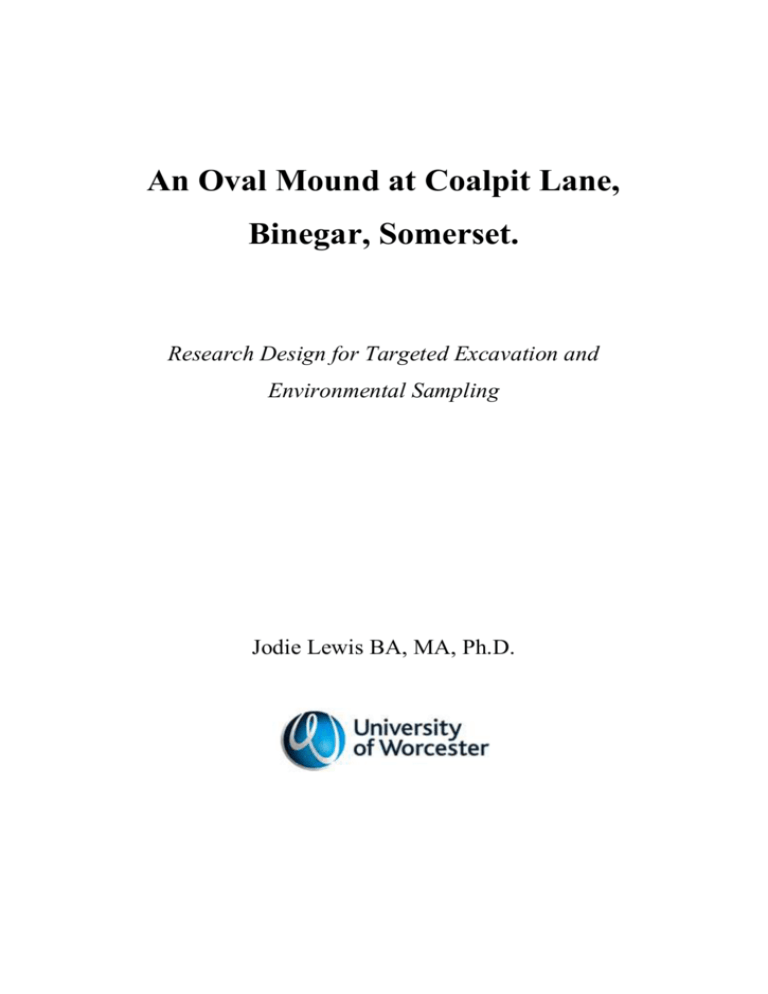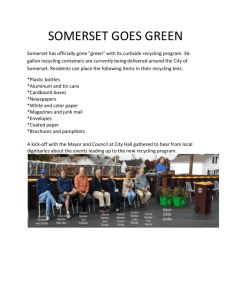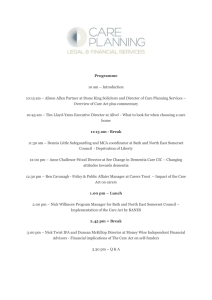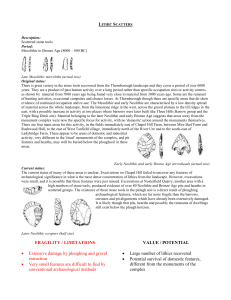Research Design
advertisement

An Oval Mound at Coalpit Lane, Binegar, Somerset. Research Design for Targeted Excavation and Environmental Sampling Jodie Lewis BA, MA, Ph.D. Research Design: Targeted Excavation of an Oval Mound at Coalpit Lane, Binegar, Somerset. SUMMARY This Research Design is a framework for research to be carried out at an oval mound in the parish of Binegar, Somerset. This work includes geophysical survey, targeted excavation and environmental sampling in an attempt to understand the date and function of the mound. The site survives as a low oval earthwork and is not a Scheduled Monument. 1. Background: 1.1 Site Location and Description The oval mound is located approximately 1 kilometre west of the village of Chilcompton, within the parish of Binegar, in the Mendip Hills region of Somerset. The NGR is ST 6304 5120. The site is located at the junction of two different geological deposits; Dolomitic Conglomerate and Mercia Mudstone. An important geological feature, the Chewton Fault, passes through the top right hand corner of the field. The soils in the field appear to belong to the Typical Argillic Pelosols group, association name Worcester. However, Typical Brown Earths, association name Crediton, are to be found very close to the east and it is possible that they also occur in the field. Topographically, the mound is located at a height of c.200m AOD, close to the northern edge of the Mendip Hills. The area falls within the general boundary zone between East and West Mendip. The mound lies almost in the middle of a small, triangular field, and the eastern and southern boundary of the field is formed by the disused line of the Somerset and Dorset railway. The field is laid to pasture and used as grazing for sheep. There is no public right of way to the mound or through the field. 2 There is considerable confusion over the date and function of the mound and it has been suggested to be either a Neolithic long barrow or one or two Bronze Age round barrows (see Section 1.2). Today, the mound measures 32m long by 16m wide, is higher and wider at the east end and survives to a height of 1m. The long barrow/twin round barrow confusion has arisen because of a constriction of the mound, about 20m from the east end. The (undated) notes of the Ordnance Survey Archaeology Division show that they believed it to be a long barrow, the narrowing a result of digging or quarrying. The site is owned by Binegar Parish Council but leased and farmed by Mr Peter Coombs. Both have kindly given permission for targeted excavations and associated research to take place. The Somerset Historic Environment Record Number for the mound is 23297. The Somerset Historic Environment Record Number for the excavation is 22902. 1.2 Previous Work The mound appears to be first mentioned in 1925, when O.G.S. Crawford interpreted it as an Early Neolithic unchambered long barrow, a suggestion later seconded by E.K. Tratman in 1938. However, L.V. Grinsell, thought it to be two Bronze Age round barrows and records it as CHILCOMPTON 1a & 1b1 in his 1971 Somerset Barrows list. There are no recorded excavations at the site but the Ordnance Survey Archaeology Division believed the constriction of the mound to be the result of digging or quarrying into what they thought a Neolithic long barrow. Leslie Grinsell, however, thought the constriction to represent the break between two separate monuments, hence his twin round barrow interpretation. Enquiries to local residents, as part of Ph.D. research by the Jodie Lewis in the 1990s, revealed that some thought that they remembered an excavation taking place at the site, possibly in the 1950s or early 1960s. One gentleman recalled that human remains were uncovered and a tent subsequently erected over the mound to shield the excavation activities. He also stated that that the Somerset and Dorset Railway was still running at this time. This section of the Somerset and Dorset Railway closed in 1966 (Atthill 1967), thus giving a terminus ante quem for the excavation. There are no records of any work in this field but a nearby round barrow, off Coalpit Lane and opposite Three Tuns Farm (see below), was 1 There exists some uncertainty whether the mound lies within Chilcompton or Binegar parish. For the purpose of this document it is described as being within Binegar parish. 3 investigated in 1954 by the Downside Archaeological Society and it seems likely that the two sites have become confused. Any excavations at the oval mound then are likely to have been by antiquarians in the 18th or 19th centuries, possibly even by the local Reverend John Skinner. The closest prehistoric monuments to the Coalpit Lane oval mound are Bronze Age round barrows. This is a linear cemetery of four barrows, Grinsell’s Chilcompton 2, 3 ,4 and 5, approximately 350 metres south-east of the oval mound. Grinsell suggests that one of these barrows (Chilcompton 4; Somerset HER Number 23295) was excavated by the Downside Archaeological Society, probably in 1954 (Grinsell 1971, 102). They found a possibly primary Early Bronze Age interment (inhumation inferred) on logs or planks (ibid.). The site has not been fully published (but see Radford 1956). The other notable monument in the vicinity of the oval mound is Blackers Hill Iron Age hillfort, lying approximately 1 kilometre to the south-east. 1.3 Reasons for the Excavation With the exception of Lewis (1996 and 2005) and Lewis and Mullin (2000), there has been little modern research into the Neolithic and Bronze Age monuments of the Mendip Hills. Lewis (2005) also undertook a series of geophysical and topographical surveys at both long and round barrow sites on Mendip with good results, illustrating the potential of this technique for identifying the layout of monuments and highlighting subsurface features. It is estimated that there are approximately 20 long barrows on or around the Mendip Hills and c.350 round barrows (Lewis 2005; Grinsell 1971), yet the limited excavations at these sites have been poor and mostly predate the twentieth century. The most recent excavation of a long barrow was at the almost destroyed Fromefield monument in 1965 by the Ministry of Works (Vatcher and Vatcher 1973) and recovered human bone and a few orthostat sockets. There are no radiocarbon dates or environmental histories for any Neolithic long barrow in Somerset and our knowledge of their physical form, the landscape in which they were built and the activities that took place within and around them are limited. Similarly, our understanding of Bronze Age round barrows in the region is equally poor, most excavations having been undertaken by antiquarians. The most modern round barrow excavation was by Lewis and Mullin (2000) at Middle Down Drove, Cheddar, though this deliberately did not target the main body of the mound. The radiocarbon dates on cremated bone from the cist below the barrow at Pool Farm, Priddy of the 1980-1765 and 1920-1735 cal BC are the only ones for any Mendip round barrow (Coles et al 2002). 4 Our knowledge of the Neolithic and Bronze Age environment is limited but it is suggested that the Mendip uplands probably supported a mixed woodland of lime, oak, ash and elm, analogous with other limestone uplands of the south-west, such as the Cotswolds (Straker and Wilkinson 2005). Animal bones associated with Neolithic and Bronze Age sites on Mendip include domesticated cow, pig and sheep as well as wild deer, boar, wolf and auroch. Evidence for cereal cultivation is extremely limited however and it appears that the environment was one of woodland and small clearances (Lewis 2005). It is probable that, like other regions, extensive woodland clearance did not become a significant feature until the middle of the Late Bronze Age or possibly even later. Parts of the landscape may have been naturally open, however, such as the acidic Old Red Sandstone uplands. Evidence retrievable by modern archaeological techniques, including excavation, geophysical survey and environmental sampling, is desperately needed for Somerset and Mendip in particular, to better understand, manage and protect this important prehistoric landscape. Mendip is one of the great barrow landscapes of Britain yet our knowledge of these monuments is pitiful and heavily dependent on the antiquarian accounts of the Reverend John Skinner. Somerset is often excluded from national prehistoric data syntheses, as research has been limited, particularly when compared with the neighbouring counties of Wiltshire, Dorset and Gloucestershire. The work proposed here will start to redress this imbalance. 1.4 Archive Deposition It is anticipated that finds from fieldwork will be deposited with Taunton Museum. The unique accession code, assigned by the museum, is TTNCM: 117/2007. The paper archive will likewise be submitted to the museum, prepared to MAP 2 standard. Any electronic data will be archived to ADS standards and guidance. 2. Aims and Objectives 2.1 Research Design The study proposed here will take the form of a three week targeted excavation at the oval mound in order to identify the date of the site and to gain information about how it may have been used. A geophysical survey (gradiometry) of the mound and its wider environs will also be undertaken prior to the excavation, which may dictate the excavation sampling strategy. Further, environmental sampling will be considered a key component of the project and samples taken from key contexts, such as buried soils, which are likely to yield the maximum data (see below and Appendix 1). 5 The study at Coalpit Lane will produce new data from the Mendip Hills. Good quality data from the region (and from Somerset more generally) for the Neolithic and Bronze Ages is scarce, with the notable exception of that from the Somerset Levels. Little modern academic research has been undertaken into these periods in the uplands (though see Lewis 2005) and our understanding is patchy. The English Heritage commissioned “South West Archaeological Research Framework” (hereafter SWARF) is also of relevance here. The Neolithic and earlier Bronze Age document (edited by Josh Pollard) notes that at an intra-regional level radiocarbon chronologies are highly variable in quality, with good coverage for certain areas, and particular horizons, such as Neolithic Wiltshire and Dorset, but less satisfactory for Somerset and Gloucestershire. The project aims to begin to redress this imbalance. It will also address some of the research aims identified in the draft SWARF Strategy, in particular: Research Aim 49: Improve our knowledge of Neolithic and Early Bronze Age social life. Research Aim 54: Widen our understanding of monumentality in the Neolithic and Early Bronze Age. Research Aim 57: Widen our understanding of Neolithic and Early Bronze Age mortuary practice. Data from this study will thus enhance the understanding of the regional sequence and also help to fit this within national frameworks. This is very much in-keeping with current research elsewhere in the UK, which is beginning to appreciate the variation within regional Neolithic and early Bronze Age sequences, perhaps as a result of social and political choice by populations at the time (Thomas 1999; Barrett 1994). 2.2 Publication and Presentation It is anticipated that the results of the project will be published within three years of the completion of the project. This will take the form of an article within a peer-reviewed journal, such as Proceedings of the Somerset Natural History and Archaeological Society or the Proceedings of the Prehistoric Society. Findings will also be disseminated through papers at academic conferences, if appropriate. 3. Methods Statement A literature review will be undertaken to place the site within its archaeological and historical context. 6 Prior to the excavation, a topographical and geophysical (gradiometer) survey of the mound and its environs will be undertaken. The fieldwork aspect of the project will then involve targeted excavation of parts of the mound. A trench will be opened by hand but it should be stressed that the sampling strategy and exact location of the trenches may be dictated by the results of the gradiometer survey, if successful. It is anticipated that this trench will measure 10m north-south by 5m east-west and be located at the eastern end of the monument. A second trench, measuring 5m east-west by 3m north-south, will also be opened by hand over the “constriction” in the southern side of the mound. Utility providers will be contacted regarding the presence of live services within the trench areas. If services are located in these areas the trench locations may be changed. After the turf and ploughsoil has been removed, deposits will be excavated by hand as stratigraphic units. These units will be given unique context numbers based on which trench they are located within and finds from each context kept separate. Finds will also be recorded in three dimensions. Contexts will be recorded on pro-forma recording sheets, based on those used by MOLAS, using standard archaeological terminology. Any archaeological features or deposits will be drawn in plan and section (at 1:20 and 1:10 scales, respectively) and photographed in both colour transparency and colour as well as black and white print. To aid recovery of small finds, deposits below the topsoil will be dry sieved. If in-situ deposits which are suitable for environmental or radiocarbon sampling are encountered these will be sampled to enable such analyses. The environmental and radiocarbon dating strategy has been prepared by Dr Michael Allen and is enclosed here as Appendix 1. The mound will be reinstated at the end of the excavation and the turves replaced. All fieldwork will be carried out in accordance with the IFA Standard and Guidance for Archaeological Field Evaluation. Post excavation analysis and preparation of the final site report will be within three years of the project’s completion. This will entail analysis of small finds and any environmental data and preparation of specialist reports. Site plans and trench locations will be drawn up in relation to the OS national grid and small finds illustrated by a suitable illustrator. 7 4. Resources and Staffing 4.1 Staffing and Equipment The project team will consist of two project managers. Site staff will consist of 15 students from the University of Worcester assisted and supervised by postgraduate students and volunteers with suitable experience. Project Managers: Jodie Lewis BA, MA, PhD., University of Worcester David Mullin BA, MPhil, University of Reading Lithics: Jodie Lewis, David Mullin Prehistoric pottery: Emily Edwards Human Bone: Christie Cox Environmental analysis: Dr Michael Allen The University of Worcester already has a supply of hand tools, geophysical kit, surveying and recording equipment and it is not anticipated that any other materials will be required for the fieldwork element of the project. Post excavation analysis will be undertaken by specialists using their own facilities, either within archaeological units or in university premises. All work will be carried out to strict health and safety regulations as laid out by SCAUM and by the University of Worcester. 4.2 Timetable Fieldwork will take place as part of the University of Worcester's student training excavation, between 3rd and 20th August 2007. The geophysical survey will take place 20-21st July 2007. The post-excavation period will last between one and two years. This will consist of analysis of small finds by specialists and the production of specialist reports and the dating of suitable materials. Any environmental data will also be assessed during this phase and if sufficient material survives in good condition this will form part of a more in-depth analysis. A full report will be written by the end of the post-excavation phase and submitted for publication. When the site has reached publication the finds and paper archive will be deposited, in accordance with UKIC's Guidelines for the Preparation of Archives for Long-Term Storage. 8 4.3 Budget The project budget can largely be subsumed within salary and fieldwork budgets of the University of Worcester. In addition, funding for post-excavation analysis has already been secured by the University of Worcester. External funding will be sought if necessary 5. Acknowledgements Thanks go to Mr Peter Coombs and Binegar Parish Council for consenting to the excavation project. Dr Michael Allen promptly agreed to prepare a full environmental and radiocarbon dating strategy document, for which I am most grateful. Chris Webster (Somerset Historic Environment Record, Somerset County Council) provided a HER number for the site and Simon Jones (Somerset County Museums Service) an acquisition code. commented on draft versions of this document. 9 David Mullin BIBLIOGRAPHY Atthill, R. 1967. The Somerset and Dorset Railway. David and Charles (Publishers) Limited. Coles,J., Gestsdóttir, H. 2002. ‘A Bronze Age decorated cist from Pool Farm, West Harptree: & Minnitt, S. new analyses’ in Proceedings of the Somerset Archaeology and Natural History Society 144, pp. 25-30. Crawford, O. G. S. 1925. The Long Barrows of the Cotswolds. Gloucester. Grinsell, L.V. 1971. 'Somerset Barrows, Part 2' in Proceedings of the Somerset Archaeology and Natural History Society, 115, pp. 44-137. Lewis, J. 2005. Monuments, Ritual and Regionality: The Neolithic of Northern Somerset. British Archaeological Reports 401, Archaeopress, Oxford. Lewis, J 1996. A Study of the Ashen Hill, Beacon Batch and Priddy Nine Barrow Cemeteries, Somerset. Unpublished MA Dissertation, University of Bristol. Lewis, J. & Mullin, D. 2000. ‘The Middle Down Drove Project: Fieldwalking, Test Pitting and Excavation in the Mendip Hills, Somerset 1997-99’ in Proceedings of the University of Bristol Spelaeological Society, 22 (2), 203-223. Radford, C.A.R. 1956. ‘Proc. & J. Downside Archaeological Society for 1954’ (Review) in Proceedings of the Somerset Archaeology and Natural History Society 99/100, p.138. Tratman, E. K. 1938. 'Fieldwork’ in Proceedings of the University of Bristol Spelaeological Society 5(1), pp.80-86. Vatcher, H 1973. 'Trial Excavations on the Site of a Megalithic Tomb at & Vatcher, F Fromefield, Somerset' in Proceedings of the Somerset Archaeology and Natural History Society 117, pp.19-32. 10









